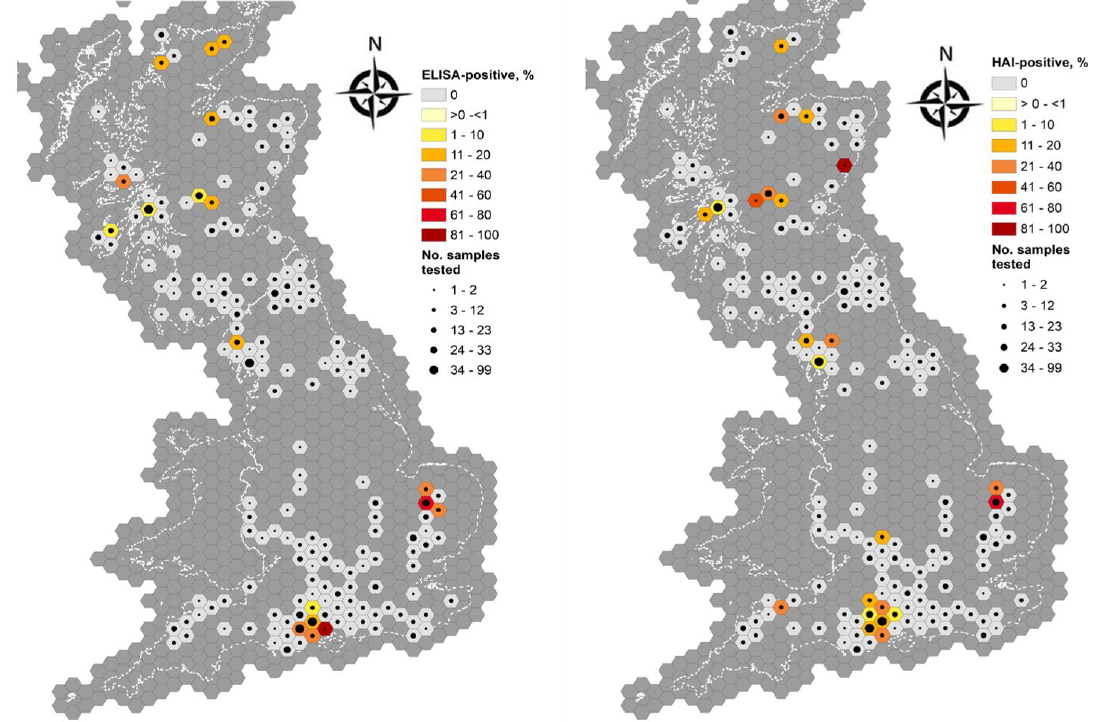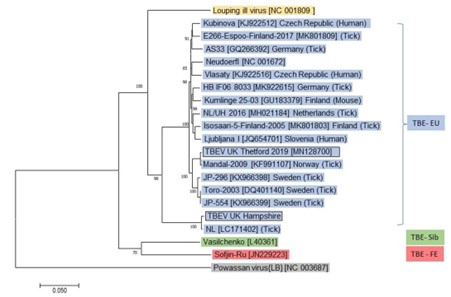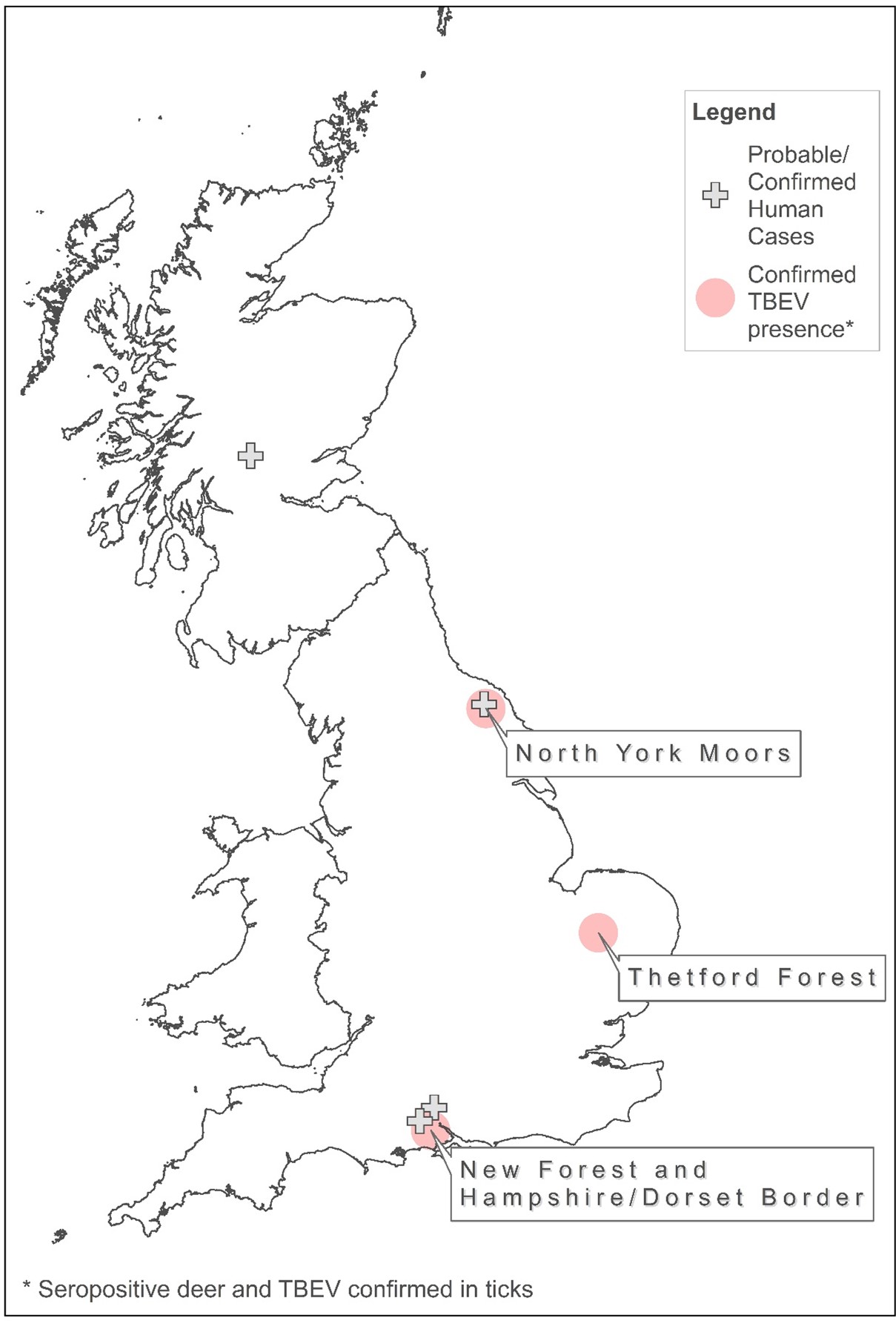Maya Holding, Gillian Ellsbury
ECDC risk status: affected (unknown if endemic)
(data as of end 2023)
History and current situation
Until 2019, TBE was considered only to be an imported disease to the United Kingdom. In that year, evidence became available that the TBEV is likely circulating in the country1,2 and a first “probable case” of TBE originating in the UK was reported.3 In addition to TBEV, louping ill virus (LIV), a member of the TBEV-serocomplex, is also endemic in parts of the UK. Reports of clinical disease in livestock, caused by LIV are mainly from Scotland, parts of North and South West England and Wales.4
National deer sentinel surveillance was conducted between 2018 and 2021, initially to establish whether TBEV might be present in Great Britain, but undetected. Following confirmation of presence this was continued, to then detect the geographic extent of TBEV and any spread. In the initial samples collected between February 2018 and January 2019,1 four percent of sera from 1,309 deer culled across England and Scotland were ELISA-positive for TBEV serocomplex. Due to the close homology between LIV and TBEV, it was not possible to differentiate between the two viruses serologically, with 73.1% of ELISA positive samples also tested by LIV hemagglutination inhibition (HAI) test being positive by both methods. Many of the seropositive samples were in areas where LIV has been reported in livestock; however, a focus of the highest seropositivity rate (47.7% by ELISA) was identified in the Thetford Forest area (South East England), which has no previously published reports of LIV in livestock. Additionally, seropositivity of 14.3% was detected in Hampshire (Southern England), also a county with no previous LIV reports. Five from 2,041 I. ricinus ticks from culled deer in ELISA-positive regions tested positive by LIV/TBE PCR5, all five were from the Thetford Forest area. Of the ticks removed from deer in the Thetford Forest area, 2.6% were positive by RT-PCR. A full-length genome sequence was obtained from one positive tick (figure 2). TBEV-UK Thetford was identified to be a TBEV-Eu strain, sharing 99% sequence identity with the Norwegian Mandal strain isolated from ticks in 2009.6
Annual tick surveys have been conducted since 2018 in areas where seropositivity in deer have been detected, additionally surveys have been conducted in localities identified through follow up of probable or confirmed TBE cases. TBEV has been confirmed over multiple years in questing ticks in parts of Thetford Forest, the New Forest/Hampshire Dorset boarder and the North York Moors. The minimum infection rate detected tends to be below 1%, to illustrate, follow-up questing tick surveys were conducted in Hampshire during July and August 2018 and June 2019. Of 915 Ixodes ricinus ticks collected and tested in 2018 and 2,155 in 2019, one RT-PCR positive pool was identified from five adult female ticks collected from a site on the Hampshire/Dorset border2. Minimum infection rate (MIR) of ticks collected from this site was estimated to be 0.17%. Sequence analysis indicates that TBEV-UK Hampshire was most closely related to TBEV-NL (LC171402.1) detected in ticks in 2017.7 The diversity of the Thetford and Hampshire TBEV-EU strains (Figure 2) indicates that these were a result of at least two separate importation events into the UK.1,2
The first “probable TBE case” originating in the UK was in a 3-month old German infant returning from a family summer vacation in South East England in July 2019.3 Based on the timing of travel and incubation period, it is not possible that the child was infected in Germany and probable exposure was thought to be in the New Forest National Park, England, following a tick bite there. A second probable case was reported in July 2020 with exposure thought to be in in the Test Valley District of Hampshire, England, less than 20km from the first probable case.15 In September 2022, a third case tested positive for TBEV by PCR was reported in England, who was likely to have acquired infection in Scotland in June 2022. In October 2022 an additional case, also confirmed by TBEV PCR, was reported in England with probable exposure in the North York Moors.8
To summarize, overall serological evidence supported by PCR detection and sequence analysis of TBEV-EU RNA indicates that TBEV circulates within the Thetford Forest and the Hampshire/Dorset border and the North York Moors areas. There have been four probable or confirmed autochthonous TBE cases, three within these areas and one in Scotland. Sequence analysis on these cases has not been possible, therefore, it is not known which TBEV strain was the cause of disease in these instances. Work is ongoing to understand the risk of TBEV to the UK human population.
Overview of TBE in the United Kingdom
| Table 1: TBE in the United Kingdom | |
|---|---|
| Viral subtypes, distribution | TBEV-EU |
| Reservoir animals | Confirmed in ticks, but likely rodents |
| Infected tick species (%) | I. ricinus |
| Diary product transmission | Not reported |
| Case definition used here | Compatible clinical signs plus serological or PCR confirmation |
| Completeness of case detection and reporting | Unknown |
| Type of reporting | Acute encephalitis is a notifiable disease.9 TBEV is now a notifiable organism (from August 2019)10 |
| Other TBE-surveillance | Ongoing surveillance for possible TBE cases. Ecological studies, in addition to both sentinel and human serosurveillance studies |
| Special clinical features | None |
| Licensed vaccines | TicoVac® and TicoVac Junior®11 |
| Vaccination recommendations | The UK Joint Committee on Vaccination and Immunisation last reviewed the situation in October 2023. It was agreed that the Green Book wording could be adjusted to highlight accessibility to vaccination for those at risk in the UK context12 |
| Vaccine uptake | Uptake of vaccine not known |
| Name, address/website of TBE National Reference Center | Rare and Imported Pathogens Laboratory (RIPL) UK Health Security Agency Manor Farm Road Porton Down Wiltshire SP4 0JG www.gov.uk/guidance/tick-borne-encephalitis-epidemiology-diagnosis-and-prevention |
Figure 1: Seropositive sentinel deer serum samples tested by both TBEV ELISA and LIV HAI and geographical distribution with density of samples (figure and accompanying legend are adapted and reprinted from reference)1

Figure 2: Phylogenetic tree highlighting the TBEV UK-Thetford and TBEV-UK Hampshire strains (figure and accompanying legend are adapted and reprinted from reference)2

Figure 3: Locations where TBEV has been detected in ticks with serological evidence in deer and suspected locations of exposure of probable/confirmed autochthonous TBE cases

Contact
Maya Holding
maya.holding@ukhsa.gov.uk
Authors
Maya Holding, Gillian Ellsbury
Citation
Holding M, Ellsbury G. TBE in United Kingdom. Chapter 13. In: Dobler G, Erber W, Bröker M, Chitimia-Dobler L, Schmitt HJ, eds. The TBE Book. 7th ed. Global Health Press; 2024. doi:10.33442/26613980_13-36-7
References
- Holding M, Dowall SD, Medlock JM, Carter DP, Pullan ST, Lewis J, Vipond R, Rocchi MS, Baylis M, Hewson R: Tick-Borne Encephalitis Virus, United Kingdom. Emerg Infect Dis. 2020;26(1):90-96. doi:10.3201/eid2601.191085
- Holding M, Dowall SD, Medlock JM, Carter DP, McGinley L, Curran-French M, Pullan ST, Chamberlain J, Hansford KM, Baylis M et al: Detection of new endemic focus of tick-borne encephalitis virus (TBEV), Hampshire/Dorset border, England, September 2019. Euro Surveill. 2019;24(47):1900658. doi:10.2807/1560-7917.ES.2019.24.47.1900658
- Kreusch TM, Holding M, Hewson R, Harder T, Medlock JM, Hansford KM, et al. A probable case of tick-borne encephalitis ( TBE ) acquired in England, July 2019. Euro Surveill. 2019;24(47):1900679. doi:10.2807/1560-7917.ES.2019.24.47.1900679
- Jeffries CL, Mansfield KL, Phipps LP, Wakeley PR, Mearns R, Schock A, et al. Louping ill virus: An endemic tick-borne disease of Great Britain. J Gen Virol. 2014;95:1005–14. doi:10.1099/vir.0.062356-0.
- Schwaiger M, Cassinotti P. Development of a quantitative real-time RT-PCR assay with internal control for the laboratory detection of tick borne encephalitis virus (TBEV) RNA. J Clin Virol. 2003;27:136–45. doi:10.1016/S1386-6532(02)00168-3.
- Asghar N, Lindblom P, Melik W, Lindqvist R, Haglund M. Tick-Borne Encephalitis Virus Sequenced Directly from Questing and Blood-Feeding Ticks Reveals Quasispecies Variance. PLoS One. 2014;9:103264. doi:10.1371/journal.pone.0103264.
- Jahfari S, De Vries A, Rijks JM, Van Gucht S, Vennema H, Sprong H, et al. Tick-Borne Encephalitis Virus in Ticks and Roe Deer, the Netherlands. Emerg Infect Dis. 2017;23:1028–30. doi:10.3201/eid2306.161247.
- Public Health England. HAIRS risk assessment: tick-borne encephalitis. 2021. Accessed March 17, 2024. https://www.gov.uk/government/publications/hairs-risk-assessment-tick-borne-encephalitis.
- The Health Protection (Notification) Regulations 2010 n.d. Accessed March 17, http://www.legislation.gov.uk/uksi/2010/659/schedule/1/made.
- Public Health England. Tick-borne encephalitis: epidemiology, diagnosis and prevention. n.d. Accessed March 17, https://www.gov.uk/guidance/tick-borne-encephalitis-epidemiology-diagnosis-and-prevention.
- Immunisation Against Infectious Disease: Chapter 31, Tick Borne Encephalitis. Green B., n.d., p. 385–90. Accessed March 17, https://assets.publishing.service.gov.uk/government/uploads/system/uploads/attachment_data/file/569289/2905811_Green_Book_Chapter_31_v3_0.pdf.
- Joint Committee on Vaccination and Immunisation. Joint Committee on Vaccination and Immunisation October 2019 Minutes. 2019.
- olding M, Dowall SD, Medlock JM, et al. Detection of new endemic focus of tick-borne encephalitis virus (TBEV), Hampshire/Dorset border, England, September 2019. Euro Surveill. 2019;24(47):1900658. doi:10.2807/1560-7917.ES.2019.24.47.1900658
- Holding M, Dowall SD, Medlock JM, et al. Tick-Borne Encephalitis Virus, United Kingdom. Emerging infectious diseases. 2020;26(1):90-96.
- Mansbridge CT, Osborne J, Holding M, Dryden M, Aram M, Brown K, Sutton J. Autochthonous tick-borne encephalitis in the United Kingdom: A second probable human case and local eco-epidemiological findings. Ticks Tick Borne Dis. 2022; 13(1):101853. doi: 10.1016/j.ttbdis.2021.101853